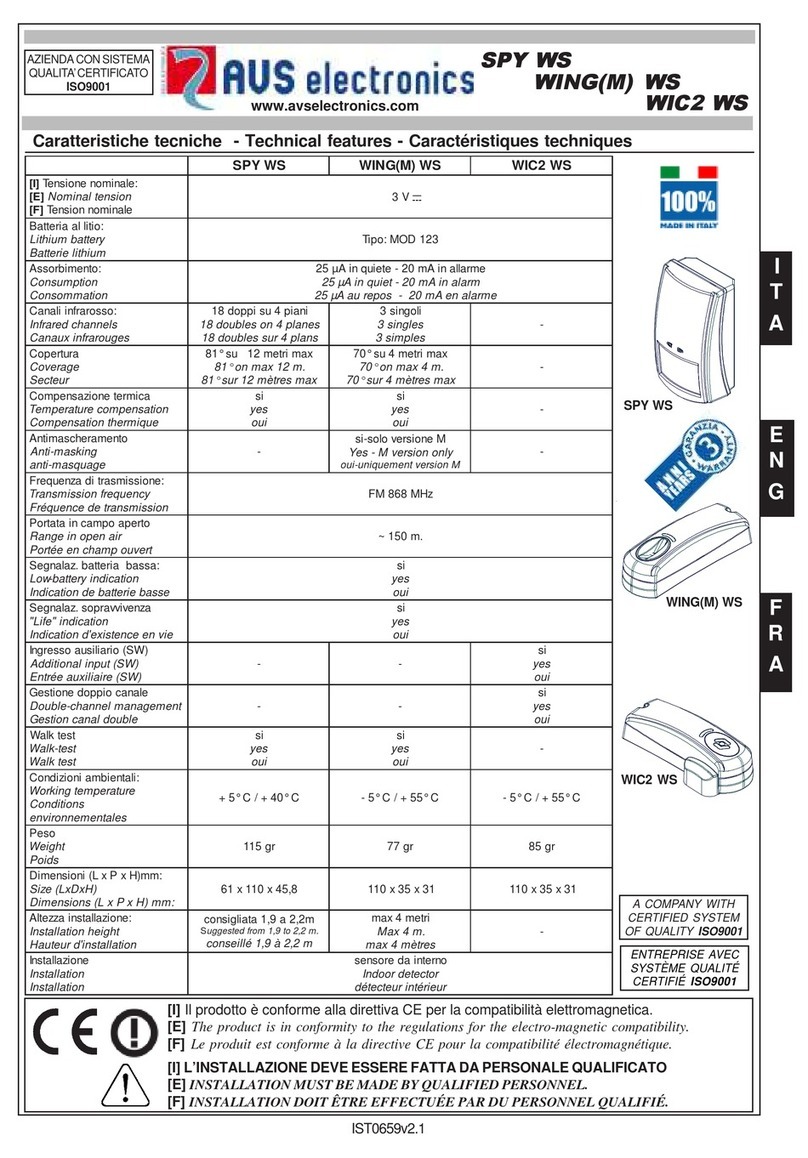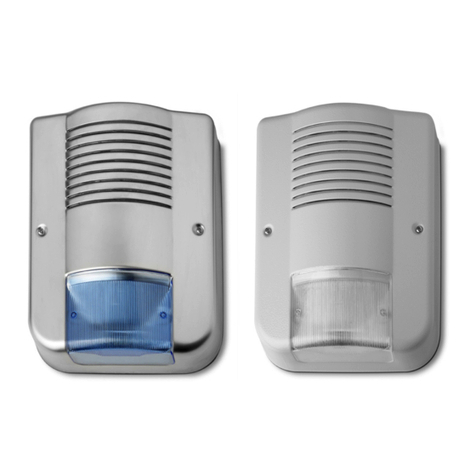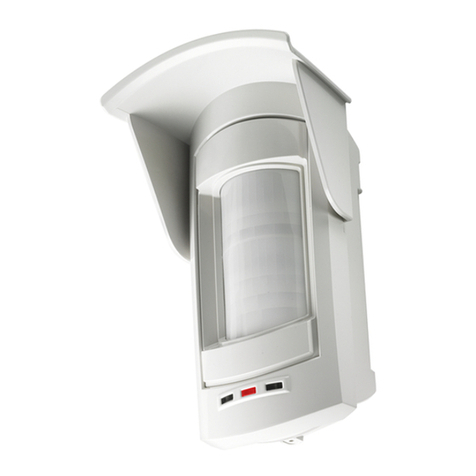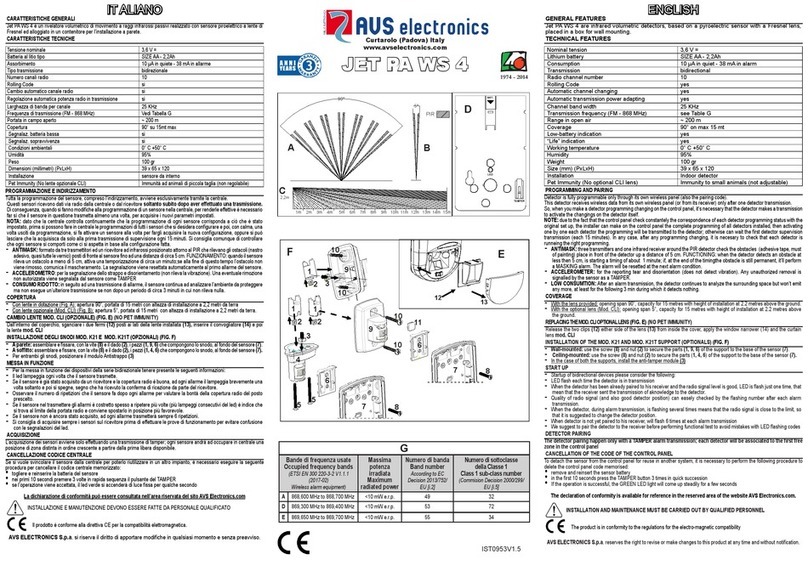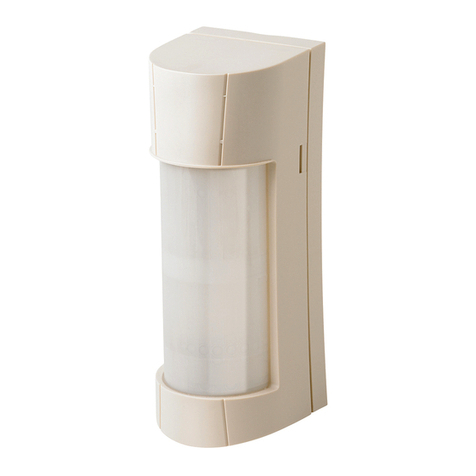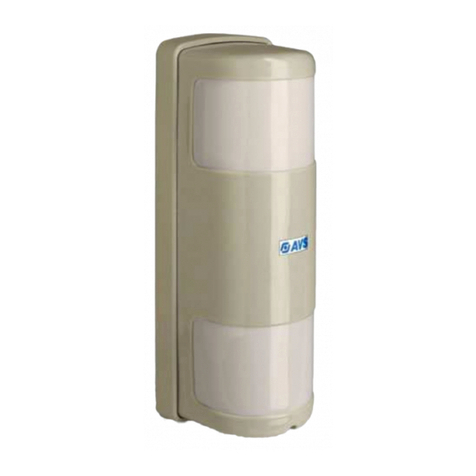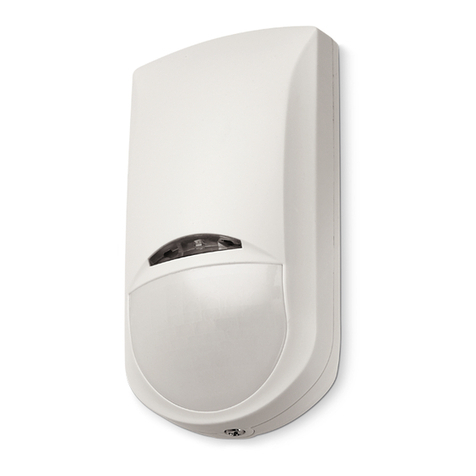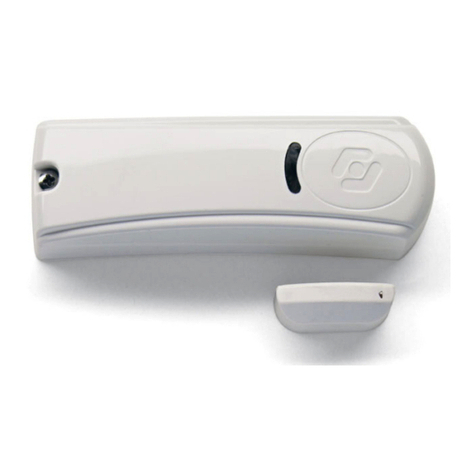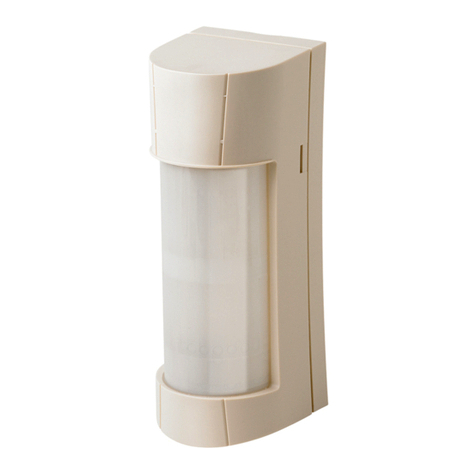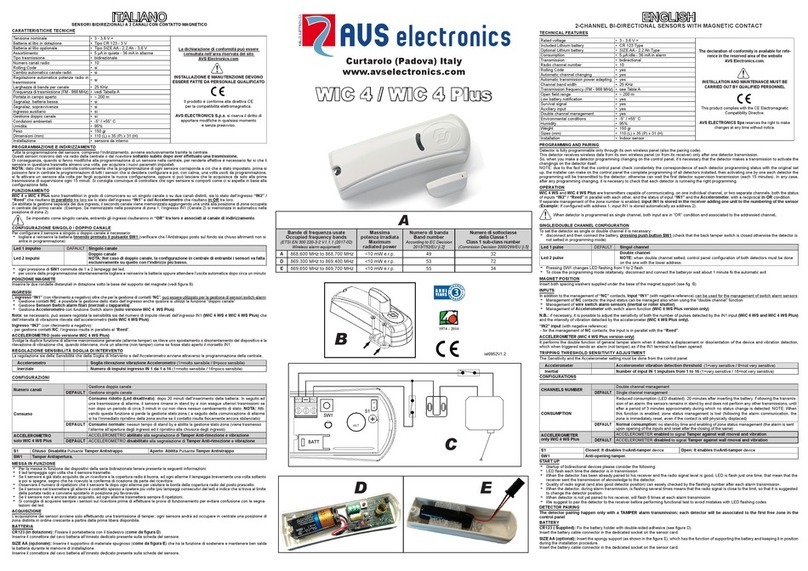
Características
- Es un detector volumétrico de movimiento, con conexión cableada, compuesto por un infrarrojo doble y una microonda plana, ideado para la protección tanto
interior como exterior.
- Sensor diseñado para proteger areas externas reduciendo al minimo las falsas alarmas debidas a condiciones meteorologicas, agentes ambientales, animales libres, etc.
- Está dotado de un zumbador y de leds para las señales óptico-acústicas (Walk Test).
- Está dotado de:
• Compensación térmica,
el sensor regula automaticamente la sensibilidad al variar la temperatura ambiente, sin embargo su prestación puede variar sensi-
blemente en ciertos intervalos de temperatura.
• Filtros de protección contra la luz blanca y la luz solar, para optimizar la lectura de los infrarrojos.
• Acelerómetro, para la señal de desgarre (no detecta la vibración). En caso de desmontaje no autorizado, el sensor emitirá una señal de TAMPER.
• Antienmascaramiento infrarrojo, formado por un receptor RX y un transmisor TX de infrarrojos activos, que detecta los obstáculos situados frente al sensor
hasta una distancia de unos 7 cm. El calibrado se realizará cuando se cierre el TAMPER (Envase y, si está presente, Antidesgarro) y durará unos 40 segundos,
durante los cuales el led Amarillo parpadeará lentamente. La señal se produce unos 30 segundos después de haber detectado el obstáculo, durante los cuales
el led Amarillo parpadea rápidamente, a condición de que mientras tanto el sensor no haya activado una alarma. Durante la señal de Antienmascaramiento, el
led Amarillo está encendido con luz ja. La señal se reseteará cuando se haya eliminado el obstáculo.
NOTA: si el led AMARILLO permanece encendido con luz FIJA durante la fase de Calibrado Antimask, signica que el sensor no logra realizar correcta-
mente el procedimiento a causa de la luz solar que golpea la lente; abrir y volver a cerrar el TAMPER para repetir el procedimiento haciendo sombra al sensor.
- Está dotado de una entrada auxiliar AUX para gestionar otra entrada de alarma o el circuito de antidesgarre del sensor.
- Está dotado de Máscaras Adhesivas Oscurecedoras para reducir el ángulo de cobertura o enmascarar una zona especíca.
- Puede estar dotado de un COBERTIZO de protección opcional (Mod. SSC PROTECCIÓN FRONT)
Instalación
Para la apertura y la instalación del sensor ver las ilustraciones impresas en el interior del paquete.
Características técnicas
Tensión nominal 12 V =
Declaración de conformidad
La declaración de conformidad se
puede consultar en el área reservada
del sitio AVS Electronics.com.
La alimentación debe proceder de un
circuito de tensión de seguridad muy
baja y que tenga las características
de una fuente con potencia limitada
protegida por un fusible.
LA INSTALACIÓN Y EL MANTENI-
MIENTO DEBEN SER REALIZADOS
POR PERSONAL CUALIFICADO
Tensión de alimentación Máx.: 15 V = / Mín.: 10,5 V =
Absorción 21 mA en reposo / 25 mA en alarma
Cobertura Spectrum DT AM:
Cobertura Spectrum DT SSL: 100° en 12 metros efectivos
100° en 12 metros efectivos
Antienmascaramiento infrarrojo sí
Frecuencia microonda
- Países de la Comunidad Europea
excepto Alemania: 10,525 GHz
- Alemania: 9,350 GHz
Señal emitida por la microonda De impulsos
Altura instalación Spectrum DT AM
Altura instalación Spectrum DT SSL de 1,2 a 1,5 metros del suelo
2,2 metros desde el suelo
Condiciones de funcionamiento de la tarjeta electrónica -25° C / +55° C
Peso (gramos) 260
Dimensiones sin COBERTIZO (milímetros) (PxLxH)
Dimensiones con COBERTIZO (milímetros) (PxLxH) 68,3 x 75,4 x 189,4
87,3 x 75,4 x 189,4
Grado de protección IP55
Primera alimentación
El sensor permanece bloqueado por unos 60 segundos durante los que los leds parpadean.
Modalidades de funcionamiento
AND: El sensor activará el relé de alarma y el led azul oscuro solamente cuando ambas tecnologías estén en alarma.
Alcance Infrarrojo (véase la FIG. F detalle 1)
-Spectrum DT AM: Instalación de 1,2 a 1,5 metros desde el suelo (FIG. B): es posible modicar el alcance del infrarrojo desde 12 hasta 3 metros
variando la altura del PIR inferior de 5 a 1
y, si es necesario, colocando el DIP 1 en ON
.
- Para variar la altura del PIR es necesario aojar el Tornillo 1 en la FIG. D. Volver a jarlo para bloquear el PIR en la posición deseada.
- Spectrum DT SSL: Instalación a una altura de 2,2 metros desde el suelo (FIG. C): el alcance es jo en 12 metros, el PIR inferior debe estar
necesariamente en la posición 1 y ser horizontal a 0° (véase la Cobertura).
NOTA: La regulación óptima del alcance se obtiene instalando el sensor perpendicularmente al suelo.
Alcance Microonda (Véase Trimmer MW en la FIG. D)
El alcance de la microonda se puede regular mediante el Trimmer MW. Aumenta en sentido horario.
Cobertura (FIG. A)
Spectrum DT AM: Instalación de 1,2 a 1,5 metros desde el suelo (FIG. B), la tarjeta electrónica se puede girar horizontalmente para variar el ángulo
de cobertura que, en cualquier caso, permanece igual a 100° en los 180° disponibles (véase la FIG. F detalle 2). Para girar la tarjeta es necesario
aojar el Tornillo 2 en la FIG. D; volver a jarlo para bloquear la tarjeta en la posición deseada.
Spectrum DT SSL: Instalación a una altura de 2,2 metros desde el suelo (FIG. C), la cobertura corresponde a 100°. La tarjeta electrónica se debe
jar en posición horizontal a 0° (véase la FIG. F detalle 2).
En algunas circunstancias, el sensor podría detectar blancos móviles, especialmente en el entorno, en ángulos por encima de 100° cobertura
nominal. Es aconsejable bloquear con las pegatinas dadas en dotaciòn los sectores de lente que no son parte de la zona de detección deseada.
Caja de bornes (FIG. B)
-Negativo de alimentación 12 V =
+Positivo de alimentación 12 V =
C / NC Salida de señal Alarma. Contacto normalmente cerrado (véase el jumper ALARM en la tabla E)
NOTA: si el jumper S1 está en posición 2 (véase la tabla E), este contacto resulta en serie respecto al de TAMPER
AM AM Salida de señal Antienmascaramiento. Contacto normalmente cerrado (véase el jumper ANTIMASK en la tabla E)
T T Salida de señal de Tamper. Contacto normalmente cerrado (véase el jumper TAMPER en la tabla E)
NOTA: si el jumper S1 está en posición 2 (véase la tabla E), este contacto resulta en serie respecto al de ALARMA
BEntrada que permite al sensor tener la referencia del estado de la central. Para gestionar esta información, esta entrada debe
resultar cerrada en positivo con la central apagada.
En esta condición el relé de alarma permanece cerrado, se interrumpe la alimentación de la microonda y, en caso de una alarma, el
led y el zumbador no se activan.
AUX AUX es una entrada con referencia al negativo que activa el relé de Alarma o el de Tamper (véase el DIP 5)
Resistencias de equilibrado (Tabla E)
Las salidas ALARM, TAMPER y ANTIMASK se pueden congurar C/NC (Jumper abierto) o con resistencias de equilibrado en paralelo (Jumper cerrado
según el valor de resistencia que se debe denir). Además se pueden separar o conectar en serie interiormente.
En la Tabla E se dan algunos ejemplos de conguraciones:
Diagrama 1. Los contactos de Alarma, Tamper y Antimask resultan independientes entre sí
Diagrama 2. Los contactos de Alarma y Tamper resultan en serie entre sí (Es necesario realizar un puente de alambre entre la alarma y el Tamper). El
Antimask es independiente.
Diagrama 3. Los contactos de Alarma y Tamper resultan en serie entre sí (Es necesario insertar uno de los 4 puentes relativa a manipular resistencia). El
Antimask es independiente.
Diagrama 4. Los contactos de Alarma y Antimask resultan en serie entre sí. El Tamper es independiente.
Diagrama 5. Los contactos de Alarma, Tamper y Antimask resultan en serie entre sí (Es necesario insertar uno de los 4 puentes relativa a manipular resistencia).
LEDS (FIG. D)
LED AZUL: durante la inicialización este led parpadea por 60 segundos. Se enciende por 1 segundo cuando el sensor da alarma.
LED AMARILLO: durante la inicialización y la calibración del antimasking esto led parpadea, pero quedan jos encendidos si la calibración no se da correctamente.
Parpadea cada uno o dos segundos cuando el sensor detecta una condición de enmascaramiento.
Dip Switch (FIG. D)
DIP 1 ALCANCE / SENSIBILIDAD ON
Reducida: para ser utilizado para reducir aún más la velocidad de ujo si
el desplazamiento de la corredera (ver Fig. F detalle 2) no fue suciente.
La microonda efectùa una analisis digital de la señal mas severa, que
tiende a excluir las oscilaciones de las plantas bajo la acciòn del viento.
OFF Por defecto
Normal
DIP 2 ENTRADA AUX (Habilitación) ON
Gestión entrada AUX habilitada
OFF Por defecto
Gestión entrada AUX deshabilitada
DIP 3 ANTIMASK ON
Antimask habilitado
OFF Por defecto
Antimask deshabilitado
DIP 4 ACELERÓMETRO ON
Acelerómetro habilitado
OFF Por defecto
Acelerómetro deshabilitado
DIP 5 ENTRADA AUX (Gestión) ON
Entrada AUX activa el relé de Alarma
OFF Por defecto
Entrada AUX activa el relé de Tamper
DIP 6 LED AMARILLO (Gestión) ON
Led Amarillo Alarma Microonda
OFF Por defecto
Led Amarillo Alarma Antimask
DIP 7 LED AZUL OSCURO y AMARILLO
(Habilitación)
ON Por defecto
Led Azul Oscuro y Led Amarillo habilitados
OFF
Led Azul Oscuro y Led Amarillo deshabilitados
DIP 8 ZUMBADOR ON Por defecto
Zumbador habilitado
Zumbador deshabilitado
En caso de instalaciones en techos de edicios industriales o civiles en general, especialmente donde hayan claraboyas u otras supercies reectoras,
y/o pavimentaciones asfalticas que sufren un fuerte calentamiento bajo el sol, se recomienda seleccionar la sensibilidad reducida del infrarojo, puesto
que tales factores favorecen la insurgencia de falsas alarmas. En todos los casos, sin embargo, ajustar siempre la sensibilidad de la microonda al
minimo valor indispensable para cubrir la distancia deseada y no mas.
Tamper
- El TAMPER antiapertura de la tapa ya ha sido instalado y cableado en fábrica.
- El TAMPER antidesgarre opcional se debe instalar en el fondo del sensor (Cód. 1135112) y se aconseja la conexión entre los bornes AUX y - (negativo)
AVS ELECTRONICS S.p.a. se reserva el derecho de hacer modicaciones en cualquier momento y sin la obligación de aviso previo.
Merkmale
- Es handelt sich um einen volumetrischen Bewegungsmelder mit Drahtanschluss, bestehend aus einem doppelten Infrarotsensor und einer planaren Mikrowellen-
leitung. Er eignet sich sowohl für die Innen- als auch für die Außenüberwachung.
- Der Sensor wurde für den Schutz des Außenbereichs entwickelt und die minimiert das Risiko von Falschalarmen aufgrund von Wetterbedingungen, Umwelteigen-
schaften, Tieren usw.
- Durch die Ausstattung mit Summer und Led wird eine akustische und optische Meldung erzeugt (Walk Test).
- Bestandteile:
• Wärmeausgleicher.
bei der der Sensor die Leistung des Systems automatisch reguliert, um Änderungen der Umgebungstemperatur auszugleichen. Seine eigene
Leistung kann jedoch in Bezug auf bestimmte Temperaturbereiche beträchtlich variieren.
• Schutzlter gegen weißes und Sonnenlicht. Dadurch wird die Infratroterfassung optimiert.
• Beschleunigungsmesser. Dieser meldet ruckweise Veränderungen (Vibrationen werden nicht ermittelt). Eine allfällige nicht autorisierte Entfernung wird vom Sensor
als TAMPER gemeldet.
• Infrarot-Abdeckungsschutz. Dieser besteht aus einem RX-Empfänger und einem TX-Sender mit aktiven Infrarotstrahlen, welche die vor dem Sensor bendlichen
Hindernisse bis zu einem Abstand von zirka 7 cm ermitteln. Die Kalibrierung erfolgt bei Schließung des TAMPERs (Behälter und, falls vorhanden, Abrissschutz) und
dauert ca. 40 Sekunden. Während dieser Zeit blinkt die gelbe Led langsam. Die Meldung wird etwa 30 Sekunden nach Ermitteln des Hindernisses erzeugt, während
welcher die gelbe Led schnell blinkt, wenn der Sensor in der Zwischenzeit keinen Alarm erzeugt. Während der Meldung des Abdeckungsschutzes leuchtet die gelbe
Led durchgehend auf. Nach Entfernen des Hindernisses wird die Meldung quittiert.
HINWEIS: Wenn die GELBE LED bei der Antimask-Kalibration mit DAUERLICHT brennt, kann der Sensor den Vorgang nicht richtig ausführen, da Sonnenlicht
auf die Linse scheint. Den TAMPER öffnen und schließen und den Vorgang wiederholen, dabei muss der Sensor im Schatten liegen.
- Der Bewegungsmesser ist mit einem Hilfseingang AUX ausgestattet, um einen zusätzlichen Alarmeingang oder den Rissschutzkreis des Sensors selbst verwalten zu können.
- Er verfügt außerdem über Verdunkelungs-Klebemasken, um den Abdeckungswinkel einzuschränken oder eine spezische Zone abzudecken.
- Er kann auf Anfrage mit einem SCHUTZDACH ausgerüstet werden (Mod. SSC «FRONT»-SCHUTZ)
Installation
Siehe Zum Öffnen und Montage des Sensors die Abbildungen auf der Innenseite der Packung gedruckt.
Technische Merkmale
Nennspannung 12 V = Konformitätserklärung
Die Konformitätserklärung kann auf
dem Server der Homepage AVS
Electronics.com nachgelesen werden.
Die Speisung muss über einen
Sicherheitskreis mit Niedrigstspannung
erfolgen, welcher über die Merkmale
einer Quelle mit durch Schmelzsiche-
rung beschränkten Leistung verfügt.
INSTALLATION UND WARTUNG
MÜSSEN VON QUALIFIZIERTEM
PERSONAL AUSGEFÜHRT WERDEN
Speisespannung max: 15 V = / min: 10,5 V =
Aufnahmeleistung 21 mA im Ruhezustand / 25 mA im Alarmzustand
Geschützter Bereich
Spectrum DT AM
Geschützter Bereich
Spectrum DT SSL
100° auf 12 effektiven Metern
100° auf 12 effektiven Metern
Infrarot-Abdeckungsschutz ja
Mikrowellenfrequenz - Europäische Gemeinschaft-Ländern außer Deu-
tschland: 10,525 GHz
- Deutschland: 9,350 GHz
Signal der Mikrowelle Impulse
Einbauhöhe
Spectrum DT AM
Einbauhöhe
Spectrum DT SSL
von 1,2 bis 1,5 m vom Boden
2,2 m vom Boden
Betriebsbedingungen Elektronikkarte -25° C / +55° C
Gewicht (in Gramm) 260
Abmessungen ohne SCHUTZDACH (Millimeter) (TxLxH)
Abmessungen mit SCHUTZDACH (Millimeter) (TxLxH) 68,3 x 75,4 x 189,4
87,3 x 75,4 x 189,4
Schutzgrad IP55
Erster Anschluss
Der Sensor bleibt ca. 60 Sekunden lang blockiert. Während dieser Zeit blinken die Leds.
Betriebsweise
AND: Der Sensor aktiviert das Alarmrelais und die blaue Led erst, wenn beide Technologien in Alarm sind.
Infrarot-Reichweite (siehe ABB. F Detail 1)
-
Spectrum DT AM:
Montage auf 1,2 bis 1,5 m vom Boden (ABB. B): Der Infrarotbereich kann von 12 auf 3 m reduziert werden, indem man die Höhe des unteren
PIR von 5 auf 1 ändert und, falls erforderlich, durch die DIP 1 auf ON.
Zum Ändern des PIR muss die Schraube 1 in ABB. D gelöst werden. Mit dem PIR in der gewünschten Position wieder feststellen.
-
Spectrum DT SSL:
Montage auf 2,2 m vom Boden (ABB. C): Die Reichweite beträgt x 12 m, der untere PIR muss unbedingt auf Position 1 und waagrecht auf
0° stehen (siehe geschützter Bereich).
HINWEIS: Die optimale Einstellung der Reichweite erzielt man durch die Montage des Sensors rechtwinklig zum Boden.
Mikrowellen-Reichweite (siehe Trimmer MW in ABB. D)
Die Mikrowellen-Reichweite kann mit dem Trimmer MW eingestellt werden. Sie wird durch Drehen im Uhrzeigersinn erhöht.
Reichweite (ABB. A)
Spectrum DT AM
: Montage auf 1,2 bis 1,5 m vom Boden (ABB. B). Die Elektronikkarte kann waagrecht gedreht werden, um den Deckungswinkel zu ändern, der
in jedem Fall 100° von den 180° verfügbaren beträgt (siehe ABB. F Detail 2). Zum Drehen der Karte muss die Schraube 2 in ABB. D gelöst und in der Folge in der
gewünschten Position der Karte wieder festgeschraubt werden.
Spectrum DT SSL
: Bei der Montage auf 2,2 m vom Boden (ABB. C), beträgt die Deckung 100°. Die Elektronikkarte muss waagrecht auf 0° festgestellt werden (siehe
ABB. F Detail 2).
Unter bestimmten Umständen könnte der Sensor erkennen Targets bewegt, insbesondere in der Nähe, bei Winkeln über 100 ° nominal Abdeckung. Es ist ratsam,
vor der Maske mit den entsprechenden Aufkleber, um die Linse Sektoren zur Verfügung gestellt, die nicht Teil des gewünschten Erfassungsbereich sind.
Klemmleiste (ABB. B)
-Minus-Speisung 12 V =
+Plus-Speisung 12 V =
C / NC
Signalausgang Alarm. Öffner (siehe Jumper ALARM in der Tabelle E)
HINWEIS: Wenn der Jumper S1 auf Position 2 steht (siehe Tabelle E), ist dieser Kontakt seriengeschaltet mit dem TAMPER.
AM AM Signalausgang Abdeckungsschutz. Öffner (siehe Jumper ANTIMASK in der Tabelle E)
T T
Signalausgang Tamper. Öffner (siehe Jumper TAMPER in der Tabelle E)
HINWEIS: Wenn der Jumper S1 auf Position 2 steht (siehe Tabelle E), ist dieser Kontakt seriengeschaltet mit dem ALARM.
BDieser Alarm ermöglicht dem Sensor, den Bezug des Zustands des Geräts zu ermitteln. Um diese Information zu verwalten, muss
dieser Eingang bei ausgeschaltetem Gerät positiv geschlossen sein.
In diesem Zustand bleibt das Alarmrelais geschlossen, die Mikrowellen werden abgetrennt und, im Falle eines Alarms, sprechen die
Led und der Summer nicht an.
AUX
AUX ist ein Eingang mit Minus-Bezug, durch den entweder das Alarmrelais oder das Tamperrelais aktiviert werden (siehe DIP 5)
Ausgleichswiderstände (Tabelle E)
Die Ausgänge ALARM, TAMPER und ANTIMASK können als C/NC (Öffner) (Jumper offen) konguriert werden oder mit parallelen Ausgleichwiderständen (Jumper geschlossen
in Funktion des einstellbaren Widerstandswertes). Sie können außerdem intern getrennt oder seriengeschaltet werden.
Einige Kongurationsbeispiele sind in Tabelle E angeführt:
Schaltplan 1. Die Kontakte Alarm, Tamper und Antimask sind unabhängig voneinander
Schaltplan 2. Die Kontakte Alarm und Tamper sind untereinander seriengeschaltet (Es ist notwendig, eine Drahtbrücke zwischen dem Alarm durchzuführen und dem Tamper).
Die Funktion Antimask ist unabhängig
Schaltplan 3. Die Kontakte Alarm und Tamper sind untereinander seriengeschaltet (Es ist notwendig, eine der Brücken 4 einzufügen betreffend Widerstand gegen Sabotage).
Die Funktion Antimask ist unabhängig
Schaltplan 4. Die Kontakte Alarm und Antimask sind untereinander seriengeschaltet. Die Funktion Tamper ist unabhängig.
Schaltplan 5. Die Kontakte Alarm, Tamper und Antimask sind untereinander seriengeschaltet (Es ist notwendig, eine der Brücken 4 einzufügen betreffend Widerstand gegen Sabotage).
LEDs (ABB. D)
BLAUE LED: Während der Initialisierung blinkt diese LED für 60 Sekunden. Während des Gehtests schaltet sie für 1 Sekunde ein, wenn ein Alarm ansteht.
GELBE LED: Während der Sensor-Initialisierung und der Abdecküberwachung-Kalibrierung blinkt diese LED, bleibt aber auf der entsprechenden Seite
eingeschaltet, wenn die Abdecküberwachung-Kalibrierung nicht korrekt ist und wiederholt werden muss. Sie blinken jeweils ein bis zwei Sekunden auf
der entsprechenden Seite, wenn eine Abdecküberwachung erkannt wurde.
Dip Switch (ABB. D)
DIP 1
REICHWEITE-SENSIBILITÄT
ON
Reduziert: verwendet wird, um die Fließgeschwindigkeit zu verringern, wenn die Ver-
schiebung des Schiebers (Detail 2 siehe F) war nicht ausreichend. Der Mikrowellen-Be-
reich führt eine genauere digitale Signalanalyse aus, welche die Schwingungen von
Panzen unter Windeinwirkung ausschließen kann
OFF Default
Normal
DIP 2 EINGANG AUX
(Aktivierung)
ON
Verwaltung AUX-Eingang aktiviert
OFF Default
Verwaltung AUX-Eingang deaktiviert
DIP 3 ANTIMASK ON
Antimask aktiviert
OFF Default
Antimask deaktiviert
DIP 4 BESCHLEUNIGUNG-
SMESSER
ON
Beschleunigungsmesser aktiviert
OFF Default
Beschleunigungsmesser deaktiviert
DIP 5 EINGANG AUX
(Verwaltung)
ON
Eingang AUX aktiviert das Alarmrelais
OFF Default
Eingang AUX aktiviert das Tamperrelais
DIP 6 GELBE LED
(Verwaltung)
ON
Gelbe Led Alarm Mikrowellen
OFF Default
Gelbe Led Alarm Antimask
DIP 7 BLAUE und GELBE LED
(Aktivierung)
ON Default
Blaue Led und Gelbe Led aktiviert
OFF
Blaue Led und Gelbe Led deaktiviert
DIP 8 SUMMER ON Default
Summer aktiviert
OFF
Summer deaktiviert
Im Falle von Dachmontagen in industriellen oder zivilen Gebäuden im Allgemeinen, vor allem, wenn Oberlichter oder andere reektierende Flächen vorhanden
sind, und/oder asphaltiertes Gelände, welches sich durch Sonneneinstrahlung stark erwärmen kann, wird empfohlen, den reduzierten Empndlichkeits-Modus
des Infrarot einzustellen, da diese Faktoren Falschalarme erzeugen können. In jedem Falle ist aber die Mikrowellenempndlichkeit immer richtig und auf den
minimalen möglichen Wert, für die erforderliche geograsche Abdeckung, und nicht höher, einzustellen.
Tamper
- Der TAMPER, der die Öffnung des Deckels verhindert, wird bereits im Werk installiert und verkabelt.
- Der optionale Rissschutz-TAMPER muss auf dem Boden des Sensors (Code1135112) installiert werden. Es wird der Anschluss zwischen den Klemmen
AUX und - (Minus) empfohlen
AVS ELECTRONICS S.p.a. behält sich das Recht vor, die eigenen Produkte in jeglichem Moment und ohne Vorankündigung zu ändern.
Caractéristiques
- Détecteur volumétrique de mouvement, avec connexion laire, constitué d’un double infrarouge et une micro-onde planaire, conçu pour la
protection intérieure et extérieure.
- Détecteur conçu pour la protection des zones extérieures et la minimisation des risques d’alarmes intempestives causées par les conditions météoro-
logiques, les éléments environnementaux, les animaux en liberté, etc
- Il est équipé d’un buzzer et d’une led qui donnent une signalisation optique-acoustique (test de déplacement).
- Il est également doté de:
• Compensation thermique,
le détecteur ajuste automatiquement ses performances selon les variations de la température environnante, cependant sa sensibilité
peut considérablement varier en fonction de certaines plages de températures spéciques.
• Filtres de protection contre la lumière blanche et celle solaire, an d’optimiser la lecture des infrarouges
• Accéléromètre, pour l’indication de tout arrachement (il ne détecte pas la vibration). Un éventuel sabotage non autorisé est signalé par le capteur
comme TAMPER.
• Anti-masquage infrarouge, constitué d’un récepteur RX et d’un transmetteur TX à infrarouges actifs, pour détecter les obstacles devant le
capteur jusqu’à une distance d’environ 7 cm. L’étalonnage est effectué à la fermeture du TAMPER (Boîtier et, le cas échéant, Anti-arrachement)
et dure environ 40 secondes, au cours desquelles la led jaune clignote lentement. L’indication est générée après environ 30 secondes après la
détection de l’obstacle, pendant lesquelles la led jaune clignote rapidement, si entretemps le capteur ne génère pas d’alarmes. Lors de l’indication
d’anti-masquage, la led jaune reste xe. La signalisation est remise à zéro après l’élimination de l’obstacle
.
REMARQUE : si la LED JAUNE reste allumée FIXE pendant la phase d’Étalonnage Anti-masque, cela signie que le capteur n’est pas en
mesure d’effectuer correctement la procédure en raison de la lumière du soleil qui frappe la lentille ; ouvrir puis refermer le TAMPER et répéter
la procédure en faisant de l’ombre au capteur.
- Il est doté d’une entrée auxiliaire AUX pour gérer une entrée d’alarme supplémentaire ou le circuit d’anti-arrachement du capteur même
- Il est doté de Masques Adhésifs pour réduire l’angle de couverture, ou masquer une zone spécique
- Il peut être protégé par une TOITURE optionnelle (Mod. SSC PROTECTION FRONT)
Installation
Pour l’ouverture et l’installation du capteur voir les illustrations imprimées à l’intérieur de l’emballage.
Caractéristiques techniques
Tension nominale 12 V = Déclaration de conformité
La déclaration de conformité peut
être consultée dans l’espace
Membres
du site AVS Electronics.com.
L’alimentation doit dériver d’un cir-
cuit à très faible tension de sécurité
et ayant les caractéristiques d’une
source à puissance limitée protégée
par un fusible.
L’INSTALLATION ET L’ENTRE-
TIEN DOIVENT ÊTRE CONFIÉS
À UN PERSONNEL QUALIFIÉ
Tension d’alimentation Max : 15 V = / Min : 10,5 V =
Absorption 21 mA au repos / 25 mA en alarme
Couverture Spectrum DT AM
Couverture Spectrum DT SSL 100° sur 12 mètres effectifs
100° sur 12 mètres effectifs
Anti-masquage infrarouge oui
Fréquence micro-onde
- Pays de la Communauté européenne,
sauf en Allemagne: 10.525 GHz
- Allemagne: 9,350 GHz
Signal du émis par la micro-onde Pulsé
Hauteur installation Spectrum DT AM
Hauteur installation Spectrum DT SSL de 1,2 à 1,5 mètres du sol
2,2 mètres du sol
Conditions de fonctionnement carte électronique -25° C / +55° C
Poids (grammes) 260
Dimensions sans TOITURE (millimètres) (PxLxH)
Dimensions avec TOITURE (millimètres) (PxLxH) 68,3 x 75,4 x 189,4
87,3 x 75,4 x 189,4
Indice de protection IP55
Première alimentation
Le capteur reste en position de blocage pendant environ 60 secondes, pendant lesquelles les leds clignotent.
Mode de fonctionnement
AND: Le capteur active le relais d’alarme et la led bleue seulement lorsque les deux technologies sont en alarme.
Portée infrarouge (voir la FIG. F détail 1)
- Spectrum DT AM: Installation de 1,2 à 1,5 mètres du sol (FIG. B) : il est possible de modier la portée de l’infrarouge de 12 à 3 mètres en variant
la hauteur du PIR inférieur de 5 à 1 et, le cas échéant, en plaçant le DIP 1 sur ON.
Pour varier la hauteur du PIR il faut desserrer la Vis 1 à la FIG. D. La xer pour bloquer le PIR dans la position souhaitée.
- Spectrum DT SSL: Installation à 2,2 mètres du sol (FIG. C) : la portée est xe à 12 mètres, le PIR inférieur doit nécessairement être sur la position
1 et horizontale sur 0° (voir Couverture).
REMARQUE : Le réglage optimal de la portée est possible en installant le capteur perpendiculairement au sol.
Portée micro-onde (voir Trimmer MW à la FIG. D)
La portée de la micro-onde est réglable au moyen du Trimmer MW. Augmente dans le sens horaire.
Couverture (Fig. A)
Spectrum DT AM: Installation de 1,2 à 1,5 mètres du sol (FIG. B), la carte électronique peut être tournée horizontalement pour varier l’angle de
couverture qui reste toutefois de 100° sur 180° disponibles (voir la FIG. F détail 2). Pour tourner la carte il faut desserrer la Vis 2 à la FIG. D, ensuite
la xer pour bloquer la carte dans la position souhaitée.
Spectrum DT SSL: Installation à 2,2 mètres du sol (FIG. C), la couverture est de 100°. La carte électronique doit être xée en position horizontale à
0° (voir la FIG. F détail 2).
Dans certains cas, le senseur pourrait détecter des cibles mouvantes, en particulier à proximité, pour les angles supérieurs à 100 ° de couverture
nominale. Il est conseillé de masquer préalablement avec les étiquettes fournies les secteurs de la lentille, qui ne font pas partie de la zone de
détection voulue
Bornier (Fig. B)
-Négatif d'alimentation 12 V =
+Positif d'alimentation 12 V =
C / NC Sortie d’indication Alarme. Contact normalement fermé (voir cavalier ALARM au tableau E)
REMARQUE : si le cavalier S1 est sur la position 2 (voir tableau E), ce contact est en série avec le TAMPER
AM AM Sortie d’indication Anti-masquage. Contact normalement fermé (voir cavalier ANTIMASK au tableau E)
T T Sortie d’indication de Tamper. Contact normalement fermé (voir cavalier TAMPER au tableau E)
REMARQUE : si le cavalier S1 est sur la position 2 (voir tableau E), ce contact est en série avec l’ALARME
B
Entrée qui permet au capteur d’avoir la référence du statut de la centrale. Pour gérer cette information, avec centrale éteinte, cette
entrée doit être fermée sur positif.
Dans cet état, le relais d’alarme reste fermé, la micro-onde est désactivée, et, en cas d’alarme, la led et le buzzer ne sont pas activés
AUX AUX est une entrée avec référence négative qui active le relais d’Alarme ou celui de Tamper (voir DIP 5)
Résistances d’équilibrage (Tableau E)
Les sorties ALARM, TAMPER et ANTIMASK peuvent être congurées C/NC (Cavalier ouvert) ou avec des résistances d’équilibrage en parallèle (Cavalier
fermé selon la valeur de résistance à programmer). En outre, elles peuvent être séparées ou connectées en série à l’intérieur.
Des exemples de conguration sont indiqués dans le tableau E :
Schéma 1. Les contacts d’Alarme, Tamper et Antimask sont indépendants entre eux
Schéma 2.
Les contacts d’Alarme et Tamper sont en série entre eux (Il est nécessaire de réaliser un pont de l entre l’avertisseur et le Tamper). L’Antimask est indépendant.
Schéma 3.
Les contacts d’Alarme et Tamper sont en série entre eux (Il est nécessaire d’insérer l’un des cavaliers 4 relative à altérer la résistance). L’Antimask est indépendant.
Schéma 4. Les contacts d’Alarme et Antimask sont en série entre eux Le Tamper est indépendant.
Schéma 5. Les contacts d’Alarme, Tamper et Antimask sont en série entre eux (Il est nécessaire d’insérer l’un des cavaliers 4 relative à altérer la résistance).
LED (FIG. D)
LED BLEU: lors de l’initialisation, ce LED clignote pendant 60 secondes. Il se met en marche pendant 1 seconde lorsque le capteur détecte une alarme.
LED JAUNE: Lors de l’initialisation et de la calibration de l’antimasque ces voyants clignotent, mais restent allumés xé si la calibration ne se fait pas correctement.
Clignote toutes les une à deux secondes lorsque le détecteur détecte une condition de masquage.
Dip Switch (FIG. D)
DIP 1
PORTÉE/SENSIBILITE
ON
Réduction: à utiliser pour réduire davantage le débit si le déplacement du coulisseau (Voir la
gure F en détail 2) n’a pas été sufsante. La section de micro-ondes effectue une analyse de
signal numérique plus grave qui tend à exclure les oscillations de plantes sous l’action du vent.
OFF Default Normal
DIP 2 ENTRÉE AUX
(Habilitation)
ON Gestion entrée AUX activée
OFF Default Gestion entrée AUX désactivée
DIP 3 ANTIMASK ON Antimask activé
OFF Default Antimask exclu
DIP 4 ACCÉLÉROMÈTRE ON Accéléromètre activé
OFF Default Accéléromètre exclu
DIP 5 ENTRÉE AUX
(Gestion)
ON L'entrée AUX active le relais d'Alarme
OFF Default L'entrée AUX active le relais de Tamper
DIP 6 LED JAUNE
(Gestion)
ON Led Jaune Alarme Micro-onde
OFF Default Led Jaune Alarme Antimask
DIP 7 LED BLEUE et JAUNE
(Habilitation)
ON Default Led Bleue et Led Jaune activés
OFF Led Bleue et Led Jaune exclus
DIP 8 BUZZER ON Default Buzzer activée
OFF Buzzer exclue
En général, dans le cas d’installations sur les toits de bâtiments industriels ou civils, mais, en particulier, en présence de puits de lumière ou d’autres
surfaces rééchissantes et/ou de sols bitumeux enrobés, présentant de forts échauffements par irradiations solaires, réduire la sensibilité de l’infrarouge,
car ces facteurs favorisent l’apparition d’alarme intempestives. Dans tous les cas, il est nécessaire de toujours régler la sensibilité de l’hyperfréquence
à la valeur minimale possible, tout en couvrant la zone de détection selon le besoin – et non plus.
Tamper
- Le TAMPER anti-ouverture du couvercle est déjà installé et câblé à l’usine.
-
Le TAMPER anti-ouverture optionnel doit être installé sur le fond du capteur (Code1135112) et une connexion entre les bornes AUX et - (négatif) est conseillée
AVS ELECTRONICS S.p.a. se réserve le droit d’apporter des modications à tout moment et sans préavis.
ESPAÑOLDEUTSCHFRANÇAIS
